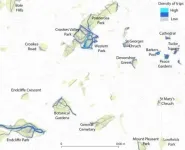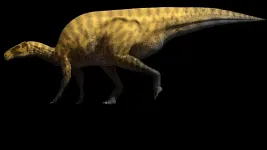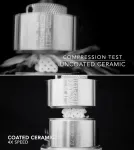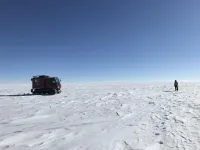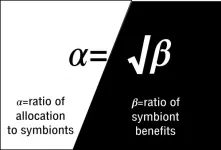Ancient Islamic tombs cluster like galaxies
Statistical methods designed for cosmology reveal tomb distribution in Sudan over millennia governed by environment and social factors
2021-07-07
(Press-News.org) Sudanese Islamic burial sites are distributed according to large-scale environmental factors and small-scale social factors, creating a galaxy-like distribution pattern, according to a study published July 7, 2021 in the open-access journal PLOS ONE by Stefano Costanzo of the University of Naples "L'Orientale" in Italy and colleagues.
The Kassala region of eastern Sudan is home to a vast array of funerary monuments, from the Islamic tombs of modern Beja people to ancient burial mounds thousands of years old. Archaeologists don't expect these monuments are randomly placed; their distribution is likely influenced by geological and social factors. Unraveling the patterns of the funerary landscape can provide insight into ancient cultural practices of the people who built them.
In this study, Costanzo and colleagues collected a dataset of over 10,000 funerary monuments in the region, distributed over 4000 km2, identified by field work and remote sensing using satellite imagery. They then analyzed the arrangement of these sites using a Neyman-Scott Cluster model, originally developed to study spatial patterns of stars and galaxies. This model revealed that, just like stars cluster around centers of high gravity, burials in Kassala cluster in the hundreds around central "parent" points which likely represent older tombs of importance.
The authors hypothesize that the larger scale distribution of tombs is determined by the environment, with "high-gravity" areas centering on regions with favorable landscapes and available building materials. Smaller scale distribution seems to be a social phenomenon, with tombs commonly built nearby older structures, possibly including recent family burials or more ancient burials of traditional importance. This is the first time this cosmological approach has been applied to archaeology, representing a fresh tool for answering questions about the origins of archaeological sites.
The authors add: "An international team of archaeologists discovered the environmental and societal drivers underlying the creation of the monumental funerary landscape of Eastern Sudan with a novel application of advanced geospatial analysis."
INFORMATION:
Press-only preview: https://plos.io/3h7fQYn
Contact: Stefano Costanzo, ste.costanzo92@gmail.com, Ph.: +39 3472907097
Image Caption: Landscape views of scatters of qubbas around the Jebel Maman.
Image Credit: Stefano Costanzo (CC-BY 4.0, https://creativecommons.org/licenses/by/4.0/)
Citation: Costanzo S, Brandolini F, Idriss Ahmed H, Zerboni A, Manzo A (2021) Creating the funerary landscape of Eastern Sudan. PLoS ONE 16(7): e0253511. https://doi.org/10.1371/journal.pone.0253511
Funding: This research was made possible through the support of the fundings awarded to the Italian Archaeological Expedition to the Eastern Sudan (IAEES) by the University of Naples "L'Orientale", the ISMEO -- Associazione Internazionale di Studi sul Mediterraneo e l'Oriente, and the Italian Ministry of Foreign Affairs and International Cooperation. The IAEES is also supported by the Regional Government of the Kassala State, Sudan. Additional financial support was provided by Italian Ministry of Education, University, and Research through the project 'Dipartimenti di Eccellenza 2018-2022' (WP4 -- Risorse del Patrimonio Culturale), awarded to the Dipartimento di Scienze della Terra 'A. Desio' (University of Milan, Italy). The funders had no role in study design, data collection and analysis, decision to publish, or preparation of the manuscript.
Competing Interests: The authors have declared that no competing interests exist.
In your coverage please use this URL to provide access to the freely available article in PLOS ONE: https://journals.plos.org/plosone/article?id=10.1371/journal.pone.0253511
[Attachments] See images for this press release:
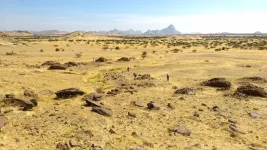
ELSE PRESS RELEASES FROM THIS DATE:
2021-07-07
GPS data from cell phones may provide insight into how city inhabitants are using their urban greenspaces, in a study published July 7, 2021 in the open-access journal PLOS ONE by Meghann Mears and Paul Brindley from the University of Sheffield, UK, and colleagues.
Urban greenspaces confer a range of health and well-being benefits on city inhabitants and provide connection to nature. In this study, Mears and colleagues use cellphone GPS data to assess how frequently residents of the city of Sheffield in the UK engage with their local urban greenspaces, and whether this engagement was different across demographic groups.
The authors used the "Shmapped" app, developed as part of the Improving Well-being through Urban Nature project, to track how frequently 240 users based in Sheffield ...
2021-07-07
New iguanodon-like dinosaur identified from jawbone fossil from Spain was likely a 6-8m long herbivore, closely related to species found in modern-day China and Niger.
INFORMATION:
Article Title: A new Styracosternan hadrosauroid (Dinosauria: Ornithischia) from the Early Cretaceous of Portell, Spain
Funding: The authors received no specific funding for this work.
Competing Interests: The authors have declared that no competing interests exist.
Article URL: https://journals.plos.org/plosone/article?id=10.1371/journal.pone.0253599
...
2021-07-07
Brain microstructure may help explain the benefits of physical activity on cognition in older adults, according to MRI scans of 318 brains post-mortem.
INFORMATION:
Article Title: Physical activity, brain tissue microstructure, and cognition in older adults
Funding: This work was supported in part by the National Institute on Aging (https://www.nia.nih.gov) grants K25 AG61254 (RJD), K01 AG64044 (VNP), K01 AG50823 (BDJ), R01 AG17917 (DAB), R01 AG47976 (ASB), R01 AG56352 (ASB), R01 AG64233 (JAS, KA), and P30 AG10161 (DAB), the National Institute of Neurological Disorders and Stroke (https://www.ninds.nih.gov) grant UH3 NS100599 ...
2021-07-07
HOUSTON - (July 7, 2021) - A thin shell of soft polymer can help keep knotty ceramic structures from shattering, according to materials scientists at Rice University.
Ceramics made with 3D printers crack under stress like any plate or bowl. But covered in a soft polymer cured under ultraviolet light, the same materials stand a far better chance of keeping their structural integrity, much like a car windshield's treated glass is less likely to shatter.
The research at Rice's Brown School of Engineering, which appears in Science Advances, demonstrates the concept on schwarzites, complex lattices that for decades existed only as theory but can now be made with 3D printers. With added polymers, they come to resemble structures ...
2021-07-07
Microscopists have long sought to find a way to produce high-quality, deep-tissue imaging of living subjects in a timely fashion. Until now, they had to choose between image quality or speed when it comes to looking into the inner workings of complex biological systems.
Such a development would have a powerful impact on researchers in biology and in neuroscience, experts say. Now Dushan N. Wadduwage, a John Harvard Distinguished Science Fellow in Imaging at the FAS Center of Advanced Imaging, along with a team from MIT, detailed a new technique that would make that possible in a report in Science Advances.
In the paper, the team presents a new process that uses computational imaging to get high resolution images at a rate 100 to 1,000 times faster than other state-of-the-art ...
2021-07-07
Increased acidity in the atmosphere is disrupting the ecological balance of the oceans, according to new research led by the University of East Anglia (UEA).
The first study to look at acidity's impact on nutrient transport to the ocean demonstrates that the way nutrients are delivered affects the productivity of the ocean and its ability to absorb CO2 from the atmosphere.
The research, 'Changing atmospheric acidity as a modulator of nutrient deposition and ocean biogeochemistry', is published today in Science Advances. The analysis was carried out by an international team of experts, sponsored by the United Nations Group of Experts on the Scientific Aspects of Marine Environmental Protection (GESAMP).
Prof Alex Baker, professor of marine and atmospheric chemistry ...
2021-07-07
To create high-resolution, 3D images of tissues such as the brain, researchers often use two-photon microscopy, which involves aiming a high-intensity laser at the specimen to induce fluorescence excitation. However, scanning deep within the brain can be difficult because light scatters off of tissues as it goes deeper, making images blurry.
Two-photon imaging is also time-consuming, as it usually requires scanning individual pixels one at a time. A team of MIT and Harvard University researchers has now developed a modified version of two-photon imaging that can image deeper within tissue and perform the imaging much more quickly than what was previously possible.
This kind of imaging could allow scientists to more rapidly obtain ...
2021-07-07
Metastatic tumors originating from notoriously aggressive triple-negative breast cancer that emerge in the lungs contain a more diverse array of cancer cells than those that arise in the liver, according to a new study in mice and organs from deceased cancer patients. The study also identified a set of genes that distinguish lung and liver metastases; together, the findings may inform future research on how targeted therapies impact tumors across various microenvironments. While scientists have known that the presence of distinct tumor cell populations within the same tumor drives breast cancer progression, it has not been fully understood why this dangerous cellular diversity develops within some tumors and not others. To investigate ...
2021-07-07
From above, the Antarctic Ice Sheet might look like a calm, perpetual ice blanket that has covered Antarctica for millions of years. But the ice sheet can be thousands of meters deep at its thickest, and it hides hundreds of meltwater lakes where its base meets the continent's bedrock. Deep below the surface, some of these lakes fill and drain continuously through a system of waterways that eventually drain into the ocean.
Now, with the most advanced Earth-observing laser instrument NASA has ever flown in space, scientists have improved their maps of these hidden lake systems under the West Antarctic ice sheet--and ...
2021-07-07
"Equal pay for equal work," a motto touted by many people, turns out to be relevant to the plant world as well. According to new research by Stanford University ecologists, plants allocate resources to their microbial partners in proportion to how much they benefit from that partnership.
"The vast majority of plants rely on microbes to provide them with the nutrients they need to grow and reproduce," explained Brian Steidinger, a former postdoctoral researcher in the lab of Stanford ecologist, Kabir Peay. "The problem is that these microbes differ in how well they do the job. We wanted to see how the plants reward their microbial employees."
In a new study, published July 6 in the journal American Naturalist, the researchers investigated ...
LAST 30 PRESS RELEASES:
[Press-News.org] Ancient Islamic tombs cluster like galaxies
Statistical methods designed for cosmology reveal tomb distribution in Sudan over millennia governed by environment and social factors

